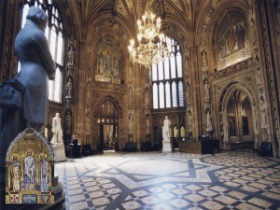St Brigid - from Kildare to the mother of Parliaments

St Brigid in Central Lobby
As we approach the feast day of St Brigid this Saturday, it is worth reminding ourselves of the wonderful mosaic of her which adorns the central lobby of the House of Commons.
Brigid, 'Mary of the Gael', abbess and patroness of Ireland, and founder of the first Irish monastery in Kildare, was born near Dundalk in 450 AD. Tradition tells us that her unbounded charity drew multitudes of the poor to her door and much enraged her father Dubhtach, a Leinster pagan Chieftain and a stubborn disbeliever. As he lay on his deathbed, she sat by him and whiled away the time weaving a cross from the rushed at her feet. Her father asked her to explain its meaning and she told him the story of how Jesus was sacrificed on the cross to pay for man's sins, and that Christ rose again and lives today. After hearing the story, the man asked for forgiveness of his sins, converted to Christianity, and then died.
It is piously believed that this rush cross, which became her emblem, keeps fire and hunger from the homes in which it is displayed. For centuries, it has been customary on the eve of her feast-day, for the Irish to fashion a St Brigid's Cross of straw or rushes and place it inside the house, over the door. St Brigid's feast day falls on the first of February, the day on which she died in 524 AD. Her body lies at Downpatrick beside the graves of St Patrick and St Columba. Like all Irish art symbols, the St Brigid’s Cross has been adapted over the years and was the Radio Telefis Eireann symbol since its inception in 1961.
I recently visited the House of Commons, on the invitation of my MP, Gloria de Piero, and was taken on a guided tour. Central Lobby is the core of the Palace of Westminster (designed by Pugin who allowed his fellow architect Charles Barry take all the credit), as a meeting place for Members of both Houses, and where MPs can meet their constituents.
It is a lofty stone octagon with an intricately tiled floor, and a rich mosaic-covered vault. Your eyes are drawn up to the crystal chandelier which lights up the mosaics, and there to my surprise was St Brigid ‘herself’ looking down at me, along with St Patrick and St Columba.
During the 19th Century, interest in mosaics had been growing, fuelled by the enthusiasm of Dr Salviati, the man responsible for restoring the mosaics at St Mark's in Venice. Dr Salviati's firm was then commissioned by the Fine Arts Commission to undertake the implementation of mosaics in Central Lobby - from the designs of Sir Edward Poynter (1836-1919). Saint George and Saint David were installed in 1869. However, by the 1920s the decoration of the Central Lobby had fallen into abeyance, and Dr Salviati had died. The commission for the remaining two Patron Saints was awarded to Robert Anning Bell (1863-1933), who was also responsible for two large mosaics in St Stephen's Hall. Bell worked on the spot, rather than in the studio, and the mosaics of St Andrew and St Patrick were finally unveiled in 1923.
Saint Patrick for Ireland stands in bishop’s robes and mitre holding a crosier. Behind him is the Rock of Cashel, which is reputed to be the site of conversion of the King of Munster by St Patrick in the fifth century. St Patrick is credited with bringing Christianity to Ireland and the mythology surrounding his life is a prominent part of Irish culture. To the right, is St Brigid who was one of St Patrick’s disciples. On the left is St Columba, a sixth-century Irish missionary monk. Above the figures is the word ‘Banba’, an ancient name for Ireland . Below them are three Irish symbols: (from left to right) the coat of arms of Ulster, the shamrock and the coat of arms of Ireland.
You can visit the Palace of Westminster by just joining the queue, at the member’s entrance. You pass by the imposing statue of Cromwell, through security to emerge into Westminster Hall where monarchs, saints and statesmen have lain in state. From there you then make your way to the gallery of either the Commons or Lords, or both.
For Prime Minister’s Question Time on Wednesday you need to reserve a ticket in advance via your MP, as this ‘parliamentary theatre’ is usually a full house! See: www.parliament.uk/visiting for more information.















